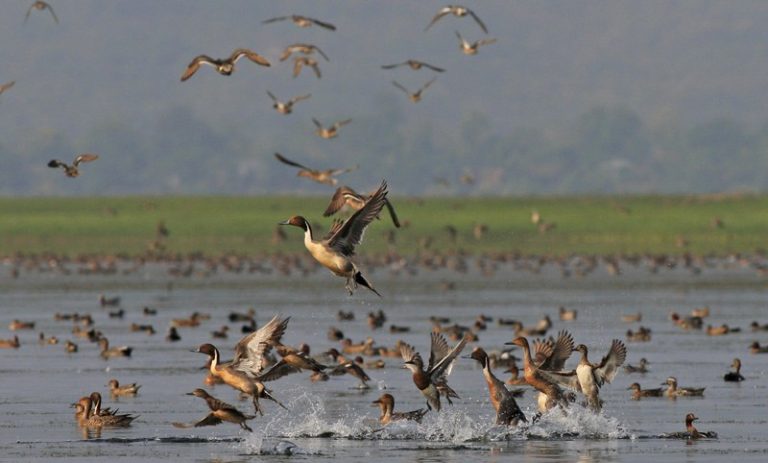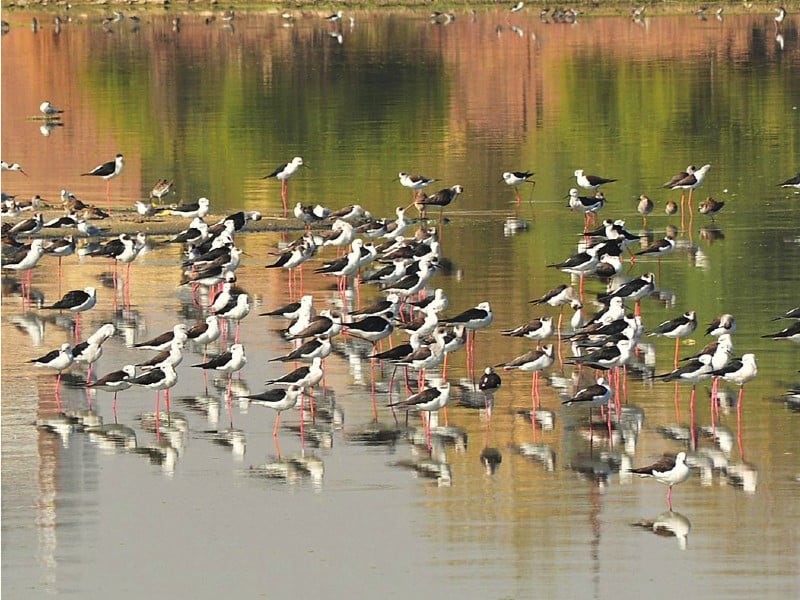
The water bodies in Hyderabad, Sindh, are facing serious challenges that are adversely affecting their ecological health and the well-being of aquatic birds
Prof Dr. Abdullah G Arijo
Fifteen years ago, while driving to university in the morning, I used to see many aquatic birds catching their prey from water bodies all along the railway track crossing Giddu Chock near Sir Cowasjee Institute of Psychiatry in Hyderabad. However, in just 10 years, land grabbers filled these water bodies with solid waste and sold the land at very high prices. If you drive on the same road today, you will see high-rise multistory buildings on either side of Auto Bhan road, which now serves as the most expensive marketplace in Hyderabad, despite the Supreme Court’s limit of six stories.
“I always wonder where these birds have gone and what happened to the lotus and water lilies that used to attract everyone to enjoy nature. It seems like almost everything has changed, and people have short memories as if there was never anything here before.”
The biosphere is in terrible trouble and biotic and abiotic ecosystems are facing destruction, ultimately vanishing the water bodies that once were habitats to several bird species to name a few.
The water bodies in Hyderabad, Sindh, are facing serious challenges that are adversely affecting their ecological health and the well-being of aquatic birds. Water pollution is a significant concern in Sindh, including Hyderabad, as the quality of water in these lakes has deteriorated due to various factors such as industrialization, urbanization, and improper waste disposal. The presence of contaminants like heavy metals, pesticides, and pathogens has contributed to this decline. Unfortunately, this pollution doesn’t only affect humans but also the aquatic ecosystem, including birds.
There are reports that, in the past, 70% of Siberian migratory birds stopped visiting Pakistan due to dried up and contaminated water bodies
Water birds, including migratory species, depend on healthy water bodies for their survival. They usually feed on aquatic weeds, insects, worms, snails, and amphibians. When water bodies are surrounded by vegetation and are not overly full, these food sources thrive, which is ideal for the birds. However, the current situation in Hyderabad’s lakes, where water bodies are too full, can negatively impact the availability of food for aquatic birds. The lack of vegetation and excessive water levels disrupt their natural feeding patterns.
 Hyderabad’s lakes have historically been important for migratory birds coming from Europe to nest and breed, but water quality and indiscriminate hunting pose challenges to their survival.
Hyderabad’s lakes have historically been important for migratory birds coming from Europe to nest and breed, but water quality and indiscriminate hunting pose challenges to their survival.
Efforts to improve water quality, prevent encroachment, and restore natural habitats are essential to create a safer environment for aquatic birds in Hyderabad. Conservation initiatives and community awareness can play a vital role in preserving these valuable ecosystems. However, the Hyderabad containment has certain other options, not supportive micro and macro ecosystems and habitats.
Read: CONSERVATION IS IMPERATIVE FOR OUR FUTURE
The water bodies of Sindh have indeed faced challenges, impacting the well-being of aquatic birds. However, there have been notable conservation efforts that have positively influenced bird populations.
The Sindh Wildlife Department (SWD) conducts an annual waterfowl census to monitor bird populations across various spots in Sindh. In the 2023-2024 census, a staggering total of 639,122 birds were recorded at nearly 30 locations, including Keenjhar Lake, Manchhar Lake, Hamal Lake, Haleji Lake, Rann of Kutch, Langh Lake, and Nariri Lagoon.
The survey team identified 11 new bird species recorded in the province for the first time. These include the Bar-headed Goose, Indian Spot-Billed Duck, Lesser Flamingo, Cotton Pygmy Goose, and more.
Once you move to the coastal belt biodiversity, the Badin district along the coastal belt has proven to be a better region for birds. Nariri Lagoon hosted 168,964 birds, while the Rann of Kutch area saw 117,790 birds.
These numbers reflect the success of conservation efforts by the SWD, creating a more peaceful and ideal environment for birds.
Despite these positive developments, challenges remain as ever. Dried-up and contaminated water bodies due to low rainfall, hunting, and netting continue to impact bird populations.
There are reports that, in the past, 70% of Siberian migratory birds stopped visiting Pakistan due to these factors.
Efforts to maintain and restore water bodies are crucial for sustaining bird diversity, but this requires small and long-term planning. By continuing conservation initiatives, we can create safer habitats for our feathered friends.
___________________
 Prof. (R) Dr. Abdullah G. Arijo is Advisor and Visiting Professor, SBBUVAS, Sakrand, Pakistan. He is Ex-Chairman, Department of Parasitology, Sindh Agriculture University and Ex-Advisor Academics & P&D to Vice Chancellor SAU Tandojam
Prof. (R) Dr. Abdullah G. Arijo is Advisor and Visiting Professor, SBBUVAS, Sakrand, Pakistan. He is Ex-Chairman, Department of Parasitology, Sindh Agriculture University and Ex-Advisor Academics & P&D to Vice Chancellor SAU Tandojam
Read: COMBATING DROUGHT AND DESERTIFICATION
Public awareness needs to be raised, school children visiting those sites as part of their school curriculum.
[…] READ: VANISHING WATERBODIES OF SINDH […]